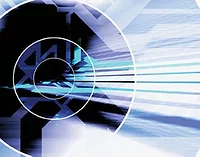Radiation-Curable Hyperbranched Polyester Acrylates

After many years of study, dendritic and especially hyperbranched materials are becoming commercially viable raw materials for industrial applications. Structurally, hyperbranched oligomers are quite different from the typical oligomers used in radiation-cure applications, having a “globular” rather than linear morphology. This three-dimensional shape leads to unique structure/property relationships and new product design opportunities. Some of the attractive features of hyperbranched materials for radiation-cure applications include low viscosity at a given MW, high end-group (acrylate) concentration, fast cure and low shrinkage. This paper discusses the structure/property relationships for a new series of hyperbranched polyester acrylates and highlights the usefulness of these products in applications such as ink jet and flexographic inks and hardcoats.

Introduction
Dendritic polymers have been the subject of intense study in both academic and industrial labs for many years.1,2 However, the commercial success of dendritic polymers in general industrial applications has been limited by their high cost, which is a direct result of the multi-step, repetitive synthesis routes required to form the highly symmetrical dendritic structure. More recently, closely related hyperbranched polymers have been developed that can be made by more industrially attractive processes, and thus, bring to market many of the features of dendritic structures at a fraction of the cost. The difference between dendritic and hyperbranched polymers is shown schematically in Figure 1.Because of their approximately spherical or globular morphology, the properties of hyperbranched polymers differ from traditional linear polymers in that they have relatively low molecular volume for a given molecular weight and have a high concentration of end groups. In addition, the end group concentration remains relatively constant as molecular weight increases. These unique structural features of hyperbranched polymers result in uncommon combinations of physical properties and opportunities for achieving interesting new properties in end-use applications. How the structural features of hyperbranched polymers might translate to physical properties and ultimately to end-use performance in radiation-cured applications is described in Figure 2.

Use in Radiation-Cured Systems
Materials with high acrylate functionality are used in radiation-cured systems because of the enhancements they can bring in properties such as cure speed, hardness, scratch resistance and chemical resistance. Use of traditional high-functionality materials, such as dipentaerythritol hexaacrylate (DPHA) or high-functionality urethane acrylates, requires a trade off with less desirable properties, such as high viscosity and high film shrinkage on cure and brittleness. The unique structural features of hyperbranched polyester acrylates may make it possible to break these paradigms.Sartomer Company has developed general methods to prepare hyperbranched polyester acrylates (abbreviated HB-PEA for the remainder of this paper) that are practical for industrial use. The products discussed in this paper have all been made using these techniques on commercial or semi-commercial scales. The five HB-PEAs that are described were designed for different end-use applications by modification of the backbone structure and level of acrylate functionality: CN2300 – inkjet or flexographic inks; CN2301 – coatings; CN2302 – inks and coatings with improved flexibility; CN2303 – inkjet inks and hardcoats; CN2304 – hard and scratch-resistant coatings. The products and their general descriptions and properties are shown in Table 1 along with DPHA, which was used for comparison in all studies.


What stands out from this data are the shrinkage results. Shrinkage was measured by comparing the density of the liquid materials and their cured films and using the equation: % -Shrinkage = 100 x (dp – dl)/dp, where dp is the density of the polymer film and dl is the density of the liquid. Despite their high functionalities, the HB-PEAs all had shrinkages of less than 10% compared to the 17% measured for DHPA under these cure conditions. Except for CN2304 all the HB-PEAs had shrinkage in the 5-7% range. Measured shrinkages at 200 and 400 fpm line speeds were within the estimated 10% error of the method for all samples.
Shrinkage of radiation-cured acrylate systems is generally accepted to depend on the molecular weight and functionality of the materials being cured3 and typically falls into the range of 10-15%. Based on the molecular weight/functionality relationship, the shrinkage of the HB-PEAs should be similar to other acrylate monomers or oligomers. Currently, the feeling is that the low shrinkage of the HB-PEAs can be explained by a combination of two factors that would both tend to limit the “pulling together” of the film as it cures: 1) a relatively high level of intramolecular polymerization and 2) the fact that while acrylate equivalent weight is quite low, the average distance between crosslinks is large. For example, in DPHA there is an average of 6.8 atoms between acrylate groups, while in CN2300 there is an average of 16 atoms, resulting in a more loosely crosslinked system.

To measure ultimate physical properties the HB-PEAs were cured with a 1500 mJ/cm2 integrated energy to give films as fully cured as possible. Properties are shown in Table 4. Data is not included for DPHA as it was too brittle to test. In all cases films with good integrity are formed. This is in contrast to DPHA, which was too brittle to test when cured under these conditions. CN2302 in particular has high tensile, elongation and modulus indicating a very tough cured film.

Conclusions
Because of their unique structure, hyperbranched polyester acrylates offer an unusual combination of features and properties in radiation-cured systems: high functionality, low viscosity, fast cure, low shrinkage and good physical properties. In contrast to other high-functionality acrylates, such as DPHA or some urethane acrylates, they cure to films that are non-brittle and tough. Ongoing work in our laboratories shows that these combinations of properties are useful in formulating new products for uses such as inkjet inks, flexographic inks, specialty coatings and various high-tech applications. In addition, the hyperbranched structure offers many opportunities for further tailoring of properties by modification of the backbone structure or type and number of end groups.
Looking for a reprint of this article?
From high-res PDFs to custom plaques, order your copy today!






